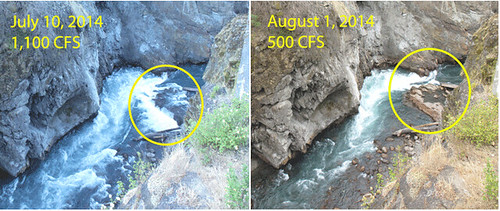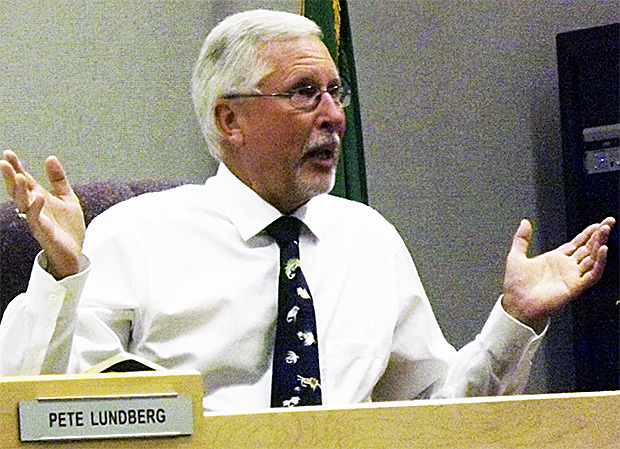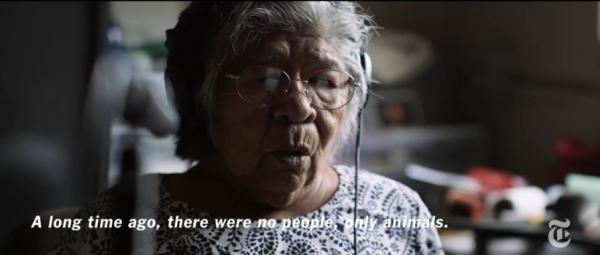The next Food Handlers class being offered at Tulalip is Thursday, September 4th from 10:00am – 12:30pm at the Tulalip Tribes Administration Building off Marine Drive. Anyone preparing or serving food on the reservation is required to have a current food worker card. Upon completion of the class and a passing test score, a food worker card will be issued which will be valid for three years from the test date. This card is valid for employment on the reservation only.
Month: August 2014
Video: Last Fluent Wukchumni Speaker Fights to Save Her Language
A recent short documentary by Emmanuel Vaughan-Lee for the New York Times profiles Marie Wilcox, of the Wukchumni, a Yokuts Tribe native to Central California.
Wilcox, who was born on Thanksgiving Day in 1933, grew up speaking mostly Wukchumni.
“I left my Indian language behind when my grandma died,” she says in the video. “I didn’t speak the language anymore until my sisters started to teach the kids. Hearing the girls trying to speak their language again made me want to learn again, and I started remembering.”
Her daughter, Jennifer Malone, explains how Wilcox would write words on whatever scraps of paper she had lying around.
“I was very surprised that she could remember all that,” Malone says in the vide. “She just started writing down her words on envelopes and papers.”
Wilcox gathered those scraps of paper up and started typing them slowly into a computer to create a Wukchumni dictionary. It took Wilcox and Malone about seven years to complete the dictionary. Now, Wilcox’s great-grandson, Donovan Treglown, is helping her record the dictionary.
Even Wilcox isn’t sure what the future holds for her language.
“I’m uncertain about my language and who wants to keep it alive, just a few—it’s sad,” she says. “It seems weird that I am the last one. It’ll just be gone one of these days maybe, I don’t know.”
But she isn’t alone, the tribe uses the dictionary Wilcox and her daughter created for weekly language classes.
Read more at http://indiancountrytodaymedianetwork.com/2014/08/24/video-last-fluent-wukchumni-speaker-fights-save-her-language-156527
Oregon coast tribe seeks federal recognition
By: Associated Press
PORTLAND, Ore. (AP) – An Oregon congresswoman wants federal recognition for the Clatsop-Nehalem Confederated Tribes on the northern Oregon coast.
A bill by Democratic U.S. Rep. Suzanne Bonamici would restore federal benefits to the Indian tribe, but not fishing or hunting rights. Recognition wouldn’t require a reservation, but allows members to live in Tillamook and Clatsop counties.
The tribe has been seeking federal recognition for several decades.
More than a century ago, the tribe signed treaties with the U.S. government that were never ratified and left the tribe in legal limbo. The Indians were forced from their lands by white settlers and in 1954 Congress – “terminated” their recognition.
Bonamici introduced the bill in the U.S. House on July 28.
Benefits for federally recognized tribes include medical and dental care, education grants and housing programs.
A Visit To The Largest Elwha River Dam In Its Final Moments
By: Ashley Ahearn, OPB
PORT ANGELES, Wash. — The National Park Service is in the final phase of the largest dam removal in U.S. history, taking place on the Olympic Peninsula.
Just 30 feet of concrete dam stand between the Elwha River and its freedom.
And early next week, it’ll be gone.
A giant orange crane moves slowly overhead as Don LaFord looks down from a narrow walkway over the Elwha River.
LaFord, a contractor for the National Park Service, has overseen the dam removal project from the beginning in 2011. Two hundred feet below where he’s standing, the river rushes by, almost completely free. Almost.
“It’ll be a final dynamite shot,” LaFord says.

Don LaFord. Credit: Ashley Ahearn
So far, a little more than half of the millions of tons of muck and debris that were lodged above this dam have been released, turning the river a chalky gray color as it empties into the Strait of Juan de Fuca, 13 miles from where we’re standing.
“I spent most of my career building power plants and this is the first one that I’ve been on where we’re demolishing hydroelectric plants,” LaFord said.
When the dams are gone he says he might retire.
Although the dam removal workers will soon be departing, fish and wildlife are doing no such thing. Salmon, otters and bald eagles are arriving upstream from where the dams blocked the flow of this river for more than 100 years.
The park service plans to have walkways installed so the public can see the former Glines Canyon and Lower Elwha dam sites in the next few months.

These two images show the difference in the Elwha River’s flow from July 10 to August 1. The remaining dam is circled in yellow in each image. Now that flows have dropped enough to expose the concrete, dam removal can begin again. Credit: National Park Service.
Biologists Discover Landlocked Chinook Salmon In Oregon
By: Cassandra Profita, Oregon Public Broadcast
It took some snorkeling and biological detective work to prove it.
But now Jeremy Romer and Fred Monzyk can confidently say they’ve found the first documented examples of Oregon chinook salmon spawning without swimming to the ocean and back.
The two Oregon Department of Fish and Wildlife biologists published their findings in an article this month in The North American Journal of Fisheries Management.
The discovery was the result of an investigation that started when they noticed something strange about the chinook salmon fishermen were catching in Green Peter Reservoir southeast of Corvallis: They looked wild.
In photographs printed in local newspapers and on the website ifish.net, several of the chinook being caught in the reservoir clearly had their adipose fins – little fins on their backs that are clipped off in hatcheries to mark the difference between hatchery fish and wild.
But there’s no way for wild fish to get to the reservoir.
The reservoir was created by Green Peter Dam on the Santiam River, a tributary of the Willamette. And the dam doesn’t have a route allowing fish passage to the ocean.
Up until 2008, the state had released excess hatchery chinook above the reservoir. But those fish were essentially trapped. They were only released so fishermen could catch them. And according to their biology, they should only have lived to 2012.
“Several pictures were of chinook captured in 2013,” Romer said. “That’s where the math didn’t add up because the last releases happened in 2008, and fish in the Willamette rarely live to age 6.”
So, the fish being caught in the reservoir couldn’t be the hatchery fish the state released in 2008 – not only because they had adipose fins but also because those fish were supposed to be dead already.
“One of the biggest clues was that we kept seeing photos in local newspapers of happy anglers with salmon we knew we didn’t put in there,” Monzyk said.
So, if these fish weren’t the hatchery chinook released by ODFW, where did they come from?
“It was an ideal opportunity for us to investigate,” Romer said.
The biologists went snorkeling and saw nine adult chinook salmon with their adipose fins intact. They also recovered six carcasses of wild-looking chinook. They ran tests to see if chemistry inside the fish indicated that they’d been to the ocean. It didn’t. Nonetheless, they found four female fish that appeared to have successfully spawned in 2012.
Their conclusion: The hatchery chinook released above the dam didn’t go to the ocean, but some of them spawned anyway. And fishermen were catching their offspring in Green Peter Reservoir.
“It’s another example of the resilience of chinook in the Pacific Northwest,” Romer said. “It’s pretty amazing that even though they can’t fulfill their regular pathways or life history they’re able to adapt and still reproduce. Like Jurassic Park, they’ll find a way.”
You may have heard of kokanee – they’re landlocked sockeye salmon. Chinook don’t usually evolve to live without going to ocean and back, Romer said. It’s been known to happen in a few places, but this is the first time it’s been documented in Oregon. Romer and Monzyk say it likely won’t be the last. They suspect a similar situation has already unfolded in Detroit Lake, southeast of Salem.
Tulalip Back to School Block Party, Aug 26
Meet The Generation Of Incredible Native American Women Fighting To Preserve Their Culture
by Danielle Seewalker, Marie Claire
Native Americans represent just one per cent of the US population and some languages have only one speaker left. Now a new generation is fighting to preserve the culture.
Meet the women leading that fight:

Evereta Thinn
Age: 30
Tribe Affiliation: Diné (Navajo)
Occupation: Administrator at a Shonto School District
When Evereta entered college as the only Native American in her English 101 class, it was at that moment she realized that she needed to speak up and not be that stereotypical ‘shy’ Indian that keeps to herself. She started bywriting an essay in that very class about living in ‘two worlds’; living in the traditional world and living in the modern world and how Native Americans need to find that balance in today’s society. ‘Knowing who you are as a Native, know the teachings from your elders and engraining them as you go out into the modern world is how you maintain that balance’. She further explains that ‘once the language fades, the culture will slowly start to go too. If the younger generations cannot speak the language, how will they be equipped to make decisions on policies and protect our tribes in the future?’ She aspires to start a language and cultural immersion school for the Diné (Navajo) people.

Alayna Eagle Shield (left) and Tonia Jo Hall (right)
Age: 24
Tribe Affiliation: Lakota & Arikara
Occupation: Teacher in the Lakota Language Nest Head Start program/Medical student
Alayna currently holds a seat in the National Native Youth Cabinet under the National Congress of American Indians (CNAI). Three key issues that she addresses on behalf of the Native youth population are the importance of language and culture, bullying, and lack of education. Her passion to keep the language alive stems from her father being one of the few fluent Lakota speakers. He chose not to speak it to her as a child, but as she grew older, she understood the importance of keeping the language alive. ‘Speaking your language is a guide to knowing who you are as a Native’, says Alayna.

Shawn Little Thunder
Age: 26
Tribe Affiliation: Cheyenne River Sioux Tribe
Occupation: Poet / Singer / Songwriter
Growing up, Shawn was severely shy and timid. It wasn’t until after graduating high school that she was urged by a musician friend to be featured in one of his songs. This was a freeing moment for her and a new outlet to express herself. She began to write poetry and join local talent shows. While holding a work position at a teen group home, Shawn encouraged the teens to keep a journal and write how they felt. Most of what the teens wrote was poetry and songs so Shawn began a poetry workshop that led to an open mic at the group home. She decided to expand her efforts and encourage others to speak freely at local events and pow wows. Rez Poetry: ‘Wičhóiye Wašaka’ (Strong Words) was the name she coined for her events. ‘That’s what I want to do, empower other Natives, especially the younger generations’.

Sage Honga
Age: 22
Tribe Affiliation: Hualapai, Hopi & Diné (Navajo)
Occupation: Server at W Hotel in Scottsdale, Arizona
Sage earned the title of 1st attendant in the 2012 annual pageant, Miss Native American USA. From that point forward, she has been encouraging Native youth to travel off the reservation to explore opportunities. In Native American culture, knowledge is power and the youth are encouraged to leave the reservations, get an education and then come home to give back to your people. ‘My tribe, the Hualapai people, is so small that I want to be a role model to show my community and youth that it is possible to come off our land and do big things’.

Juliana Brown Eyes-Clifford
Age: 23
Tribe Affiliation: Oglala Lakota & Samoan
Occupation: Musician, photographer, film maker, artist
Juliana and her husband, Scotti Clifford, have formed the band, ‘Scatter Their Own’ (which is the English translation for the word Oglala). They travel to various Indian reservations and other parts of the country to play their music. They are self-taught, cannot read music and play what comes out naturally from their hearts. Juliana is inspired to play for the youth and inspire them to branch out and learn about the arts and music which are topics not generally exposed on the reservation. The songs they write are about Mother Earth, social justice and about the Native American culture.

Kelli Brooke Haney
Age: 33
Tribe Affiliation: Seminole, Creek and Choctaw
Occupation: Musician / Artist
As the daughter the internationally recognized Native American artist and former Chief of the Seminole Nation, Enoch Kelly Haney, it’s no shock that artistic and bold talent radiate from the ever-inspiring Kelli Brooke. In the early 2000s she formed a rockabilly band with her best friend called The Oh Johnny! Girls and also has a solo music project called Hudson Roar. Kelli grew up in a household where her parents spoke Seminole Creek as the first language. She is also the mother to a sweet five-year old boy, Jack, and expresses the importance of raising him with Native American traditions as well as encouraging him to embrace his own artistic talents.

Juanita C. Toledo
Age: 28
Tribe Affiliation: Walatowa-Pueblo of Jemez
Occupation: Works for the Community Wellness Program on Jemez Pueblo Reservation
Growing up, Juanita was valedictorian of her charter school, President of the Native American Youth Empowerment (NAYE) group, and on the executive committee of UNITY (United National Indian Tribal Youth Organization). During college things changed dramatically for Juanita. She felt the pressure of life and quickly fell into depression, anxiety and succumbed to drugs and alcohol after dealing with a very traumatizing family event. ‘It was the worst time of my life; I really thought I was going to die and I wanted to die’. In 2012, she had a turning point. ‘I started to believe in my dreams and in myself again.’ She ran for Miss Indian World, one of the most prestigious honours a Native American woman could receive. Although she didn’t take the title, her tribal community was extremely proud of her representation. Today, she works for the Community Wellness program on her reservation and has truly influenced positive changes in the program and in her community.
See more images and read the full story in the September issue of Marie Claire.
Read more at http://www.marieclaire.co.uk/blogs/547176/meet-the-generation-of-incredible-native-american-women-fighting-to-preserve-their-culture.html#MWbYWw3Kys2cYPEv.99
M’ville, teachers union reach tentative contract

— image credit: Steve Powell
By: Steve Powell, Marysville Globe
MARYSVILLE – The Marysville School District and its teachers have come to a tentative contract agreement.
The teachers will vote on the proposed contract Wednesday, Aug. 27.
The school board will meet Sept. 2 to ratify the contract, as long as the teachers agree to it. The district and the teachers union have been working for months on the plan.
Meanwhile, at the school board meeting Aug. 18, the board approved a grant application for the district’s Highly Capable Program. Director Todd Christensen explained that new this year is a state requirement to identify highly capable students in kindergarten and first grade.
“We are already gearing up for that,” Christensen said, adding the initial screening will be done by mid-year with services starting after that.
The new law also requires professional development for teachers regarding HiCap and a report to the state school’s chief’s office to make sure “we are truly identifying” highly capable students, Christensen said.
Along with being intelligent, other factors for highly capable students are: creative, potential to perform, work habits, study skills and problem solving, he added.
He also explained that HiCap is not a supplemental program but a part of basic education. He said there are HiCap self-contained classes at Pinewood Elementary in grades 2 through 5, but other schools also have services. In middle schools there are blocks of classes in math, social studies and language arts. In high school there are Advanced Placement, honors, Running Start and more opportunities.
The board also discussed its strategic direction at the meeting, called “Engage, Inspire, Prepare.” The vision is “Engaging our Community, Inspiring our Students, Preparing our Graduates.” Under each strategy is a list of things to be done to make sure the goals are reached.
For example, under Engaging the Community the plan is to foster family involvement, responsibility for each student and nurturing community partnerships. There are then seven goals and activities listed under that, including designing and implementing a Parent Academy, partnering with the Tulalip Tribes and implementing student support teams.
Board member Pete Lundberg said he has seen a lot of visions over the years, but this one is actually workable.
“This has involved spirited debates, and they are not over yet,” he said. “This isn’t something we can do alone. We are trying our darndest to include the community. We’re going to continue to look for ways to engage the community.”
In other school news:
• The Public Utility District gave a check for more than $55,640 to the district as an incentive for reducing kilowatt hours.• Second-grader Claire Hudson of Pinewood Elementary and Logan Galley, a third-grader at Marysville Cooperative Program, took first place in regional competition for bus safety posters and advanced to state.
• Sandra Brock, a librarian at Cedarcrest and Marysville middle schools, will be featured in a national publication called School Library Journal for August. The story is about student-centered libraries and how they break the stereotype of librarians, who are now more open and embrace new technology.
• The district’s Back to School guide will be posted online at www.msvl.k12.wa.us. It includes bus schedules, key dates and more. It also will come in the mail.
Salal harvest permits for Olympic National Forest on sale on four dates starting next month
Source: Peninsula Daily News
OLYMPIC — Olympic National Forest has announced four dates on which permits for commercial salal collection will be sold.
The dates are Sept. 10, Nov. 5, Jan. 7 and March 18 at the Forks, Quinault, and Quilcene district offices.
Salal is an understory shrub commonly used in the floral industry.
It grows in dense thickets throughout Western Washington and Oregon.
A total of 100 permits will be available on each of the sale days, divided among different harvest areas.
Each permit will cost $150 and can be used for up to two months.
On each sale day, 50 permits will be offered from the Quilcene office for harvest areas located within Mason County and the east side of Clallam and Jefferson counties.
Twenty-five permits will be offered from the Forks office for the west side of Clallam County.
Twenty-five permits will be offered from the Lake Quinault office for harvest areas within Grays Harbor County and the west side of Jefferson County.
Harvest unit boundaries are defined by roads or recognizable land features. A map of the harvest areas will be distributed with the sale of each permit.
Permit holders will be limited to no more than 200 hands per day. One hand equals about 20 to 25 stems.
The Forest Service recommends that salal harvesters wear at least one piece of high-visibility clothing while in the woods.
A lottery system will be used if the demand for permits exceeds the supply.
A valid United States picture identification will be required at the time of purchase, and those buying the permits must be at least 18 years of age.
Cash or checks only will be accepted; credit and debit cards will not be accepted.
Only one permit may be purchased per person per sale day.
For more information about salal permit sales, phone Chris Dowling, special forest products program manager, at 360-956-2272.
Contaminated heroin can cause botulism

Increased botulism infections seen in the region’s heroin users
Tulalip, Niki Cleary
In an alert from the Snohomish County Health District, local health officials were notified that Harborview Medical Center is seeing more heroin users coming in with Clostridium botulinum wound infections. Their conclusion? Likely an infected batch of heroin is being sold in this area. While many community members may not recognize the bacterium, they’ll probably recognize it’s affects, widely known as botulism.
“Normally we see this [botulism] in preserved foods,” said Bryan Cooper, ARNP Family Practice Provider at Tulalip’s Karen I Fryberg Health Clinic. “Tar heroin comes from a plant, it’s sap from the poppy, so basically the sugars there provide food for this particular bacteria. We talk about pasteurizing food, we kind of flash heat them to kill the bacteria, but they [drug dealers] don’t do that with heroin, because they don’t care.”
In any case, killing the bacteria with heat won’t solve the problem.
Cooper continued, “When users heat heroin to melt it and inject it, they kill the bacteria. But it’s not the bacteria that cause the symptoms. The bacteria produce a neurotoxin as a waste product, so even though the bacteria is dead, the neurotoxin is still there. The neurotoxin causes the double vision, slurred speech and other symptoms.”
The neurotoxin causes paralysis. When the paralysis affects the heart or lungs, the affected person dies.
“The treatment is to get an anti-toxin as soon as possible,” said Cooper. “Here’s the thing, if the onset is rapid, if it’s a high dose or you are susceptible to it, it can progress so fast that you don’t have signs and symptoms. When it goes to your respiratory system, it’s all over.”
Things to look for: Double vision, blurred vision, drooping eyelids, slurred speech, difficulty swallowing, dry mouth and muscle weakness. The user may also note blood colored discharge at the injection site.
“People who have been around a heroin user will notice that they ar acting differently.” Cooper described the effects, “You don’t necessarily get slurred speech with heroin. Here, we’ll actually see drooping eyelids while the user is awake. There will be difficulty swallowing, and even when they’re not high, these symptoms won’t go away.
“It can progress to death pretty quickly depending on the dose,” Cooper warned. “If you experience any of these symptoms, you need to neutralize the toxin as soon as possible. If we saw someone here with a confirmed case, we would send them to the emergency room and call the Snohomish County Health District so they could get the anti-toxin there right away.
“You can liken it to a snakebite,” Cooper said. A rattlesnake bite might be a low enough dose that you’ll live through it, but it’s not worth the risk of waiting. The sooner you receive the anti-venom, or in this case, the anti-toxin, the less damage it will cause.
“Recovery from botulism can last for months,” Cooper explained. “You want to administer the anti-toxin as early as possible to reduce the severity. Even though you’ve given the anti-toxin, the damage is already done. Your body has to recover from that damage.”
Injection is the likeliest way to contract botulism from heroin, but even smoking heroin doesn’t guarantee that you won’t be exposed to the disease.
“Bad teeth, bleeding gums, these can all be entry ways for botulism toxin,” described Cooper. “According to the World Health Organization (WHO), inhalation botulism is similar to foodborne botulism, but symptoms become noticeable from one to three days after exposure. It’s possible that smoking contaminated heroin could cause a user’s clothing to be contaminated. The contaminated clothing could then expose others to the toxin. The WHO’s recommendation is for the patient to shower and their clothing to be stored in plastic until it can be decontaminated by washing in soap and water”
Although, he acknowledges that heavy drug users may not notice if they are affected, Cooper explained that community members and other users can save a life by looking for these symptoms.
“There are some of us who give people rides,” said Tulalip citizen Willa McLean, “so, awareness is crucial. In case we see something on the individual, we’ll know what to do.”
Cooper pointed out that this won’t affect all needle users, for example, if you have diabetes and inject insulin, you are safe because the legal product you receive goes through numerous safeguards to ensure that it’s free from contaminants. Likewise, you can’t catch botulism the way you can catch the common cold.
“Botulism is a toxin given off by bacteria, so when the user injects contaminated heroin and therefore the toxin, they are essentially poisoned. If the needle is shared, there’s a risk that there may be a small amount of toxin in the needle or syringe. It’s not a pathogen, therefore not blood borne, airborne or contagious.”
For more information about botulism check on-line at http://www.cdc.gov/nczved/divisions/dfbmd/diseases/botulism/professional.html.











